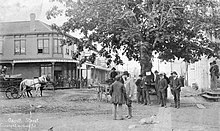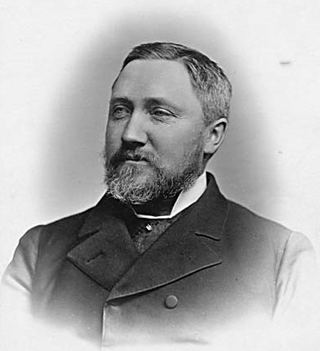
Malcolm Alexander MacLean was the first mayor of Vancouver, British Columbia, serving from 1886 to 1887.

Gastown is the original settlement that became the core of the city of Vancouver, British Columbia, Canada, and a national historic site and a neighbourhood in the northwest section of the Downtown Eastside, adjacent to Downtown Vancouver.

John Deighton, better known as "Gassy Jack", was a bar-owner in British Columbia. The Gastown neighbourhood of Vancouver, British Columbia takes its name from him.

The Second Narrows Rail Bridge is a vertical-lift railway bridge that crosses the Burrard Inlet and connects Vancouver with the North Shore. The bridge's south end connects directly to the Thornton Tunnel, which connects it to the main Canadian rail network. As the name suggests, it is located at the second narrowing of the Burrard Inlet.

Kitsilano is a neighbourhood located in the city of Vancouver, British Columbia, Canada. Kitsilano is named after Squamish chief August Jack Khatsahlano, and the neighbourhood is located in Vancouver's West Side along the south shore of English Bay, between the neighbourhoods of West Point Grey and Fairview. The area is mostly residential with two main commercial areas, West 4th Avenue and West Broadway, known for their retail stores, restaurants and organic food markets.

False Creek is a short narrow inlet in the heart of Vancouver, separating the Downtown and West End neighbourhoods from the rest of the city. It is one of the four main bodies of water bordering Vancouver, along with English Bay, Burrard Inlet, and the Fraser River. Granville Island is located within the inlet.

The District of North Vancouver is a district municipality in British Columbia, Canada, and is part of Metro Vancouver. It surrounds the City of North Vancouver on three sides. It is largely characterized as a relatively quiet, affluent suburban hub home to many middle and upper-middle-class families. Homes in the District of North Vancouver generally range from mid-sized family bungalows to very large luxury houses. A number of dense multi-family and mixed-use developments have popped up across the district in recent years; however, the district remains a primarily suburban municipality. It is served by the Royal Canadian Mounted Police, British Columbia Ambulance Service, and the District of North Vancouver Fire Department.

Coal Harbour is a section of Burrard Inlet lying between Vancouver's Downtown Peninsula and the Brockton Point of Stanley Park. It has also now become the name of the neighbourhood adjacent to its southern shoreline.
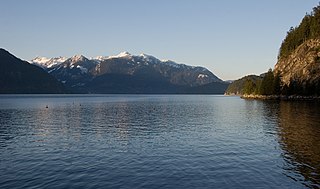
Howe Sound is a roughly triangular sound, that joins a network of fjords situated immediately northwest of Vancouver, British Columbia, Canada. It was designated as a UNESCO Biosphere Reserve in 2021.
This page is a listing of federal and provincial electoral districts located in the City of Vancouver, British Columbia, and for ridings which include the name Vancouver in their title, including those on Vancouver Island among which was the original first-use of the riding-name Vancouver. For ridings in any of the suburbs other than North Vancouver and West Vancouver, please see New Westminster (all other Lower Mainland ridings are descendants of the original New Westminster riding. Vancouver Island ridings not including the name "Vancouver" can be found at Vancouver Island.

The history of Vancouver, British Columbia, is one that extends back thousands of years, with its first inhabitants arriving in the area following the Last Glacial Period. With its location on the western coast of Canada near the mouth of the Fraser River and on the waterways of the Strait of Georgia, Howe Sound, Burrard Inlet, and their tributaries, Vancouver has – for thousands of years – been a place of meeting, trade, and settlement.

Grandview–Woodland, also commonly known as Grandview–Woodlands, is a neighbourhood in Vancouver, British Columbia, Canada to the east of the downtown area, stretching south from the shores of Burrard Inlet and encompassing portions of the popular Commercial Drive area. It is a mature neighbourhood in Vancouver that is a vibrant mixture of commercial, industrial, single-family and multi-family residential with a rich ethnic history and features.
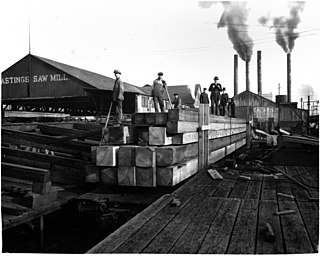
Hastings Mill was a sawmill on the south shore of Burrard Inlet and was the first commercial operation around which the settlement that would become Vancouver developed in British Columbia, Canada. Founded in 1865 by Edward Stamp, the sawmill operated until its closure in 1928.
August Jack was an Indigenous/Aboriginal chief of the Squamish people. He was born in the village of Xwayxway or Chaythoos on the peninsula that is now Stanley Park, Vancouver, British Columbia, Canada, the son of Supple Jack "Khay- Tulk" of Chaythoos and Sally "Owhaywat" from the Yekwaupsum Reserve north of Squamish, British Columbia. His grandfather was Chief Khahtsahlano of Senakw who had migrated from his home at Toktakanmic on the Squamish River to Chaythoos, and the man from whom he inherited his name. The suffix "lan-ogh" in their name means "man".

Sen̓áḵw or sən̓aʔqʷ, rendered in English as Snawk, Snawq, Sneawq, or Snawkw, is a village site of the Indigenous Squamish people, located near what is now known as the Kitsilano neighbourhood of Vancouver, British Columbia, Canada. In 1869 the Colonial Government set aside land around the village, and in 1877 the Joint Reserve Commission established by the Provincial and Federal Governments to deal with land allotments to indigenous people in B.C., expanded the area set aside to approximately 80 acres (32 ha) as False Creek Indian Reserve No. 6 or more popularly the Kitsilano Indian Reserve. The village site was home for many Squamish, but after further settlement began in the Vancouver area, the inhabitants were forced to relocate to other nearby villages. This village was also the home of August Jack Khatsahlano, a prominent chief of the Squamish and a notable Vancouver historian on local Indigenous history.
This is a timeline of the history of Vancouver.
Granville was the name from 1870 to 1886 for what would become the townsite of Vancouver, British Columbia. The townsite included the original settlement of Gastown.
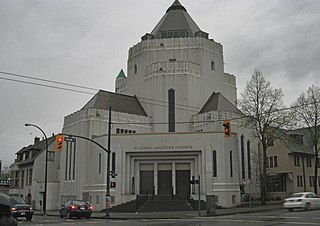
St. James' Anglican Church is a unique church building in the Diocese of New Westminster of the Anglican Church of Canada located at the north-east corner of East Cordova Street and Gore Avenue in the City of Vancouver, British Columbia, Canada in what is now its east Downtown and Strathcona neighbourhoods containing the Downtown Eastside district.
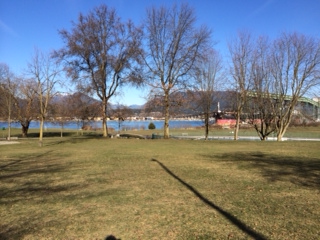
Located in the Hastings-Sunrise district of Vancouver, British Columbia, Canada, New Brighton Park is a waterfront park facing the North Shore Mountains with beach access to the Burrard Inlet. The park is surrounded by industrial plants, the Hastings Racecourse, as well as access to the Port of Vancouver. During the summer, the park becomes a popular location for recreational activity. There is a soccer pitch, tennis courts, barbecue/picnic sites, two playgrounds, beaches, and an outdoor pool. For local residents, New Brighton Park provides a nearby location with similar facilities found at other popular recreational parks such as Kitsilano Beach, which is located on the west side of Vancouver. New Brighton Park is also in the process of being connected to Hastings Park via Creekway Park, which will allow people to walk and cycle between the two locations.

In the late 1870s, Squamish and Tsleil-Waututh communities on the North Shore of Burrard Inlet experienced an increase of physical and economic encroachment from the expansion of neighbouring Vancouver. Faced with urbanization and industrialization around reserve lands, Squamish and Tsleil-Waututh traditional economies became increasingly marginalized, while government-imposed laws increasingly restricted Native fishing, hunting, and access to land and waters for subsistence. In response, these communities increasingly turned to participating in the wage-labor economy.

